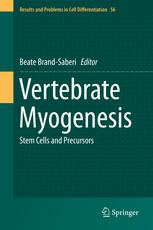Vertebrate Myogenesis: Stem Cells and Precursors 2014
دانلود کتاب پزشکی میوژنز مهره داران: سلول های بنیادی و پیش ساز
| نویسنده |
Beate Brand-Saberi |
|---|
| تعداد صفحهها |
242 |
|---|---|
| نوع فایل |
|
| حجم |
5 Mb |
| سال انتشار |
2014 |
89,000 تومان
این کتاب به کنترل تمایز عضلات اسکلتی در مکانهای مختلف بدن مهرهداران میپردازد و توجه ویژهای به مولکولها و سیگنالهای تنظیمکننده جدید و همچنین ناهمگونی منشأ که همپوشانی رشدی بین ماهیچههای اسکلتی و قلبی را نشان میدهد، شده است. گروههای عضلانی عملکردی مختلف محصولات تکامل طبقات مهرهداران هستند که مقایسه فیلوژنتیکی را برای درک نقش سلولهای بنیادی و پیشساز عضلانی در میوژنز ارزشمند میسازد. بینشهای جدیدی در مورد سلسلهمراتب فاکتورهای رونویسی، بهویژه در زمینه این گروههای ماهیچهای مختلف، از تحقیقات دقیق روابط مکانی-زمانی و تنظیمی ناشی از ژنتیک موش و گورخرماهی و میکروجراحی پرندگان به دست آمده است. نکته مهم این است که مکانیسم های اپی ژنتیکی اخیراً ظهور یافته، به ویژه نقش MyomiRs نیز بررسی شده است.
با در نظر گرفتن بیمار انسانی، نتایج دلگرمکنندهای در شناسایی شباهتهای بین میوژنز جنین و بازسازی فیبر عضلانی به دلیل مولکولهای تنظیمی مشترک به دست آمد. از سوی دیگر، هر دو فرآیند در کیفیت و پیچیدگی فرآیندهای مورد استفاده تفاوت زیادی دارند. جالب توجه است، تنوع در منابع جنینی که گروههای ماهیچهای اسکلتی در مهرهداران از جمله بدن انسان از آن منشأ میگیرند، تفاوتهایی را در حساسیت آنها به دیستروفی عضلانی خاص و همچنین ویژگیهای سلولهای ماهوارهای درگیر در بازسازی دارد. پیشرفت در زمینه زیست شناسی سلول های بنیادی عضلانی با تمرکز ویژه بر سلول های ماهواره ای در این کتاب توسط متخصصان این حوزه شرح داده شده است. نویسندگان بینشهای اخیر در مورد ماهیت ناهمگن این سلولهای ماهوارهای را در رابطه با امضای ژنتیکی و پتانسیل بازسازی آنها مرور میکنند. علاوه بر این، درک بهتر سلولهای بنیادی عضلانی تنها زمانی امکانپذیر است که تأثیر محیط سلولی را بر درمانهای جایگزین سلولهای بنیادی مؤثر برای دیستروفی عضلانی مطالعه کنیم، و نتایج جنینی از کلاسهای مختلف مهرهداران و رویکردهای سلولهای بنیادی را در زمینه قرار دهیم.
This book addresses the differentiation control of skeletal muscle in different locations of the vertebrate body Particular attention is paid to novel regulatory molecules and signals as well as the heterogeneity of origin that have revealed a developmental overlap between skeletal and cardiac muscle. Different functional muscle groups are the product of the evolution of the vertebrate classes, making a phylogenetic comparison worthwhile for understanding the role of muscle stem cells and precursors in myogenesis. New insights into the hierarchy of transcription factors, particularly in the context of these different muscle groups have been gained from detailed investigations of the spatio-temporal and regulatory relationships derived from mouse and zebrafish genetics and avian microsurgery. Importantly, epigenetic mechanisms that have surfaced recently, in particular the role of MyomiRs, are also surveyed.
With an eye to the human patient, encouraging results have been generated that identify parallels between embryonic myogenesis and regenerating myofibers due to common regulatory molecules. On the other hand, both processes differ considerably in quality and complexity of the processes employed. Interestingly, the heterogeneity in embryonic sources from which skeletal muscle groups in the vertebrate including the human body take origin is paralleled by differences in their susceptibility to particular muscle dystrophies as well as by the characteristics of the satellite cells involved in regeneration. The progress that has been made in the field of muscle stem cell biology, with special focus on the satellite cells, is outlined in this book by experts in the field. The authors review recent insights of the heterogeneous nature of these satellite cells regarding their gene signatures and regeneration potential. Furthermore, an improved understanding of muscle stem cells seems only possible when we study the impact of the cell environment on efficient stem cell replacement therapies for muscular dystrophies, putting embryological findings from different vertebrate classes and stem cell approaches into context.




